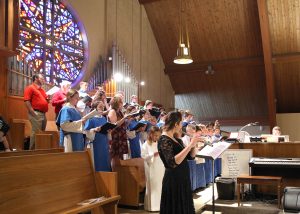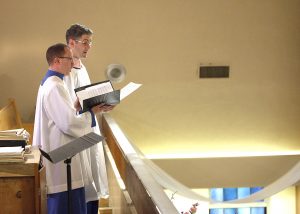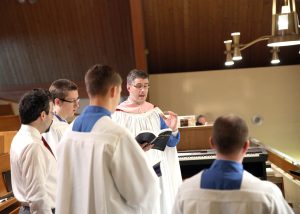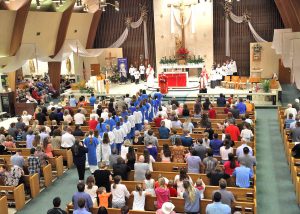Recently a friend and priest commented to me that he felt some seminarians and young priests were far too focused on the exterior details of the Sacred Liturgy, ultimately missing Christ in the celebration of the Sacraments (personally, I think his comments were directed more to me than to certain seminarians). To be fair, he is a very good priest with a heart after the Heart of Christ, one who both believes and practices an orthodox Faith (and celebrates the Liturgy beautifully and reverently) and believes these things are essential to the mission of the Church, which seeks “to baptize all nations.” Nevertheless, I want to address this somewhat common, if negative, assumption about younger Catholics, whether clerical or lay, based on my experience working for the Church.
First, as a church musician and liturgist, my job IS to be concerned with the Sacred Liturgy. It would be a dereliction of my duties were I not. Can you imagine engaging someone to teach your children who didn’t have any interest in them? It’s a comical thought.
Second, I find that those who make such an accusation usually don’t understand the connection between cult and culture, that how we pray determines what we believe, and that what we believe determines where we focus our lives. Perhaps a homely analogy will demonstrate my point.
My wife and I love our children dearly and work to create strong familial bonds that will help us in our work to form virtuous children who will one day arrive at Heaven’s shore (and take care of us in our dotage!), and nowhere does this happen more than at the dining room table. Early on, my wife and I realized that the majority of our human and Christian formation came to us through our parents as we sat down each night to supper, so we decided to give our children the same gift. Like so many other things, though, the devil has been in the details and we have had to pay attention to these details along the way, while not losing focus on the end goal.
When we moved into our house 5 years ago, we found that our dining room was the most uninspiring room in the whole house. It was rather depressing. We still sat down every night to supper and spent quality time together, but it wasn’t until we gave the room a new coat of paint, nice window treatments and hung quality pictures on the walls that we found we couldn’t wait to spend time it that room. Supper hadn’t changed; we didn’t love our children more (at least not for that reason); but we anticipated our time together more.
The next addition was a new (at least to us) dining room table. Our home is an 80+ year old colonial and I had always dreamed of beautiful Georgian table as the final touch in the room, but knew I could never justify what would amount to half a year of college tuition to pay for such an heirloom. God, however, in His eternal sense of humor inadvertently brought my attention to such a table and chairs for 10 in solid mahogany and brass on Craigslist for a fraction of the cost. As I paid for the table, I wondered if the inlaid table top would survive our boys, who had the unfortunate habit of dragging the points of their silverware across the table. We purchased place mats for everyone and instituted a policy that one’s plate, cup and silverware always had to stay on the place mat and that everyone had to stay in his chair until were finished.
We also had to fix the problem of our children starting to eat before we got to the table, so we taught them to stand behind their chairs until we had prayed. Only then would we ALL sit down. As the final touch, we decided that on Sundays and feast days we would pull out the wedding china and my grandmother’s wedding silver to give the day a real specialness.
My wife and I often comment that supper is our favorite time of the day. We ask each of our children to tell us what their greatest joy of the day was as well as their greatest sorrow and we sometimes read a short biography of the day’s saint. We find that supper is where we have really grown as a family and where we have learned so much about our children. It is also where we talk intentionally about our Faith with our children. This is our evangelization time, if you will. Some people might acuse my wife and I of focusing too much on the details to the detriment of letting our children be kids by trying to recreate long gone social customs or pretending that we are somehow higher on the social ladder than other people, but nothing could be further from the truth. We are resigned to the fact that wedding china will break (and has broken) and that milk will continue to spill from precariously stemmed glassware. They are, after all, just things, but they are sacramentals in the sense that they speak to us about the beauty of the vocation of a Christian family and they reinforce in us the desire to become the family God has called us to be.
Some time ago we spent a few days with extended family who regularly passed out paper plates to everyone in an effort to keep things easy. The table was usually half full of groceries or toys that had to be pushed aside, and which caused people to eat all over the house. My wife commented later that she missed getting to spend quality time at the table with everyone and I couldn’t have agreed more.
In the same way, I focus on beauty in the externals of liturgy and music not because I worship them, but because I love God and He is worth it. Every so often (although not nearly enough) I get flowers for my wife and my naturally frugal mind always cringes at the cost, but I am amazed how such a simple gesture brighten’s my wife’s entire day and I find that by “wasting” my money on her, I find freedom and joy. To be honest, focusing on the external aspects of liturgy engages very little of my day. Even at home I don’t sit around talking to my family about liturgy. We pray together and pass on the Faith to our children, but I can’t remember that I have ever engaged my children in a discussion about the aesthetics of the liturgy, even on their own level.
I am sure that there are those seminarians and priests and laymen who are too focused on the externals of liturgy, but don’t forget they exist on both sides of the liturgical divide. I would venture to say that in the past 50 years there have been more than a fair share of priests and seminarians who were overly focused on the liturgy in an effort to destroy all that was holy and good, including Faith in Christ. Perhaps the supposed over emphasis on the Liturgy among younger Catholics today is just a response to its devaluation since the 1960s. I have said it before and will say it again: if the Sacred Liturgy is where we meet the Lord, then there you will find me.



